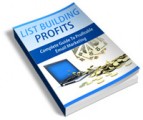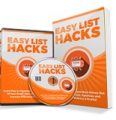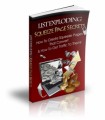Salespage Snapshot:

>>> Click Here To View Full Sales Page…
Table of Contents
Introduction to List Segmentation Master 3
Uncovering High Value Customers … 7
Deadbeat Subscribers . 9
Using Segmentation Features . 11
Maximizing Response Rates … 14
A/B Split Testing ….. 14
Changing your Offers & Messages ….. 14
Mailing More or Less Often .. 15
Offering More Incentives …… 15
Holding Contests …. 16
Ask What Subscribers Want . 16
Customize Messages …. 17
Boosting Profits With Follow Ups…. 18
Recommended Resources …… 21
Sample Content Preview
Uncovering High Value Customers
One of the most important things that list segmentation can do is help you identify your very best customers – in other words, those who buy most often, spend the most money, and are most responsive to your broadcasts and messages.
It’s always important to reward those who buy from you regularly and who have proven to be loyal customers. By identifying who on your list spends the most money, you’ll be able to offer them rewards and incentives, discounts, etc. that other list members don’t receive. In other words, you are making them feel appreciated just for being loyal and in turn, they will continue to do so.
For example, you could segment your list so that anyone who spent at least $100 in the last year would be included in a specific broadcast. Those people might then receive a 50% discount coupon on your newest product (or some other limited & exclusive offer), and you could specifically tell those buyers the coupon is only for your “best customers”. That would make them feel like they made the right decision spending their money with you while making some extra money from the sale!
Your best customers should always be treated like kings. This is a very easy way to make sure you are doing that. By sending them regular thank you gifts and letting them know they are receiving these “exclusive offers” because they bought something recently or they read your emails often, it will make them even more likely to buy from you and read your emails in the future.
In addition to spoiling your best customers, you may also want to create special products or private deals specifically for them that you wouldn’t otherwise offer. Perhaps something like a one-on-one mentoring course, private discount on training, or a product that is highly limited in sales that only your “best customers” get a chance to purchase. This is another way to ensure they stay happy and keep buying from you!
Deadbeat Subscribers
Another great way to segment lists is by determining who on your list is a deadbeat subscriber. What exactly is a deadbeat subscriber, you might ask?
A deadbeat subscriber is someone who has demonstrated a total lack of interest. He or she has not made a purchase from you, he/she rarely (or never) opens your emails, he/she has not responded to any of your free offers, etc. In other words, he/she may as well not be on your list at all. They are completely unresponsive.
You may wonder why you should even bother segmenting these people. After all, they aren’t hurting anything, right?
Well, yes and no. The fact is, subscribers cost money. Most email service providers’ charge you based on how many subscribers you have. Let’s say every 1,000 members costs an extra $5 per month. Having an extra 20,000 deadbeat subscribers on your list would cost you $100 per month! That’s no small chunk of change, especially when it’s all for nothing. These people will never respond to your offers, they simply aren’t interested – and so they should be quickly removed from your list.
But before you zap them forever there is something you could do as a “last resort effort” to ensure that they are not interested in your offers. Send the “deadbeat” group a message by segmenting who hasn’t responded to offers in the past and notify them that they will be removed in the future.
That message could be a simply warning that he/she could be removed from your list and miss valuable offers because they haven’t demonstrated interest. Your message could also include be some kind of incentive such as, “Hey {NAME}, I noticed you haven’t bought anything through my newsletter in a while, so I thought I’d take the time to offer you this 50% off coupon.”
This could turn deadbeats into valuable list members, or at the very least, save you some money by purging them.
Using Segmentation Features
There are many different ways to segment your lists so that you’re able to “divide and conquer” your subscribers while being able to better understand what they are most interested in.
Different methods of list segmentation will be more effective than others depending on what your qualifiers are. For example, age segmentation would more valuable and important to someone marketing to seniors or college students than to someone selling weight loss products.
It’s up to you to decide which segmentations will work best for your subscriber list, but it’s important to always test different types of filters so that you can begin to group subscribers based on the demographics that make it easier for you to target.
Here are some various types of segmentation you might want to use, and a little bit of information about why each one could be useful:
1. Gender – Segmenting by gender could be extremely useful if your products are mostly useful or of interest to one gender. It can also be helpful if you have a different version of your products for different genders, or if you want to promote gender-specific affiliate products. Additionally, it could be helpful if you promote a product that might offend or alienate one gender.
2. Age – Age segmentation is especially useful if you’re marketing to a very specific age-related group. For example, if you’re marketing to high school or college students or seniors, you might want to segment your list according to age.
3. Employment Status – Segmenting by employment status is especially useful if you sell products geared toward business and employment. For example, you might want to send emails about a resume-writing guide to those who are currently unemployed.
4. Geographic Location – Segmenting by location can be beneficial if you have different versions of your product for different languages. It could also be very important if your product only applies to people who live in a certain area, or is more beneficial to people who live in certain places.
5. Purchase History – Purchase history is one of the most useful segmentation types, because it can let you know if a subscriber is a “deadbeat” or not. A deadbeat subscriber is someone who has not made a purchase from you within a specific length of time. You can either remove those people from your lists, or you can tailor your promotions specifically to them in order to potentially increase response.
6. Purchases – You can also segment by what they purchased, how much they spend, how often they bought from you, etc. By segmenting this way, you can send certain promotions to people who spend the most or least, those who buy rarely or often, or those who buy specific items.
7. Relationship Status – If you sell products that relate to dating or relationships, this type of segmentation could be extremely vital. For example, you might not want to send an ad for “how to get your ex back” to someone who is married, because it might damage their current relationship if their partner sees it and thinks they’ve requested the information. And if someone is single, they probably won’t be interested in a product about how to keep a marriage happy.
8. Abandoned Shopping Carts – If your list works with your ecommerce system, you may even be able to segment your list according to people who have abandoned their purchases. It’s been discovered that up to half of all ecommerce transactions are abandoned before the sale is completed. If you segment these people, you can send them a message tailored to asking them why they abandoned their purchase and what you can do to get them to complete it.
9. Read History – If you segment your list according to who actually opens your emails and reads them most often, you can reward those who loyally open your messages most often with special incentives. Then you can tell those who rarely read your messages what they’re missing out on by not reading them!
As you segment your lists, remember that these factors can change. You probably won’t have a way to allow your subscribers to update their information in your system, so someone who is single when they subscribe could get married, and someone who is unemployed when they subscribe could get a job.
Still, segmentation is extremely useful in many ways. It will allow you all kinds of ways to improve your list’s responsiveness, from sending the right messages to the right people, to removing deadbeats and tailoring messages to specific groups.
Other Details- 1 Ebook (PDF, DOC), 19 Pages
- 7 Part Autoresponder Email Messages (TXT)
- 1 Squeeze Page (HTML, PSD)
- File Size: 19,448 KB














